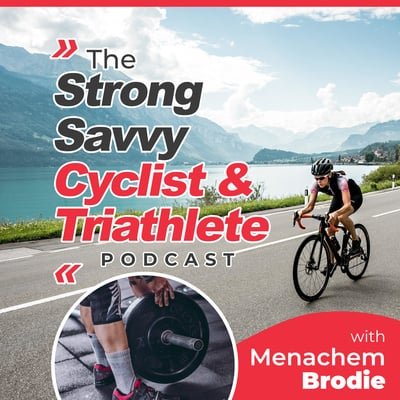Dean Somerset is a Physical Therapist, Strength Coach, Trainer, and Fitness Industry Educator who has been presenting and sharing his experience for the last 12+ years with folks around the world. He’s written for TNation, Men’s Health, and a plethora of other websites and publications, as well as has a number of fantastic workshops.
Dean’s been on my “to talk to” list on the topic of Strength Training for Cyclists for quite some time now, as I noticed in one of his Videos that his wife had a Cervelo P3 in their home gym….And todays conversation did not disappoint! Dean has been working with a number of cyclists in his hometown of Edmonton, Alberta, and shares with us what he’s doing, what’s worked, and some important considerations.
So get your pen & notebook ready, as we dive into some fantastic conversation about best practices, do’s and don’ts as well as things you should be thinking about, but probably are not.
You can find Dean at www.DeanSomerset.com
In this Episode:
- Dean Somerset
- Mindset Evolution
- Squat Loading and Methods
- Individual Body Awareness
- Breathing Training
- Shoulder Position
- Spine Range of Motion
- Injury Prevention
- Tissue Adaptation in Strength Training
- Road Cyclists’ Gym Volume
- Hips and Rotary Stability
- Conclusion
Show Notes:
0:41 –
Dean Somerset
- Plethora of knowledge
- Has been presenting for over a decade
- The Complete Trainer’s Toolbox
- The Complete Hip and Shoulder Blueprint
- With Tony Gentilcore
- His wife is a cyclist
- He trained cyclists and paracyclists up in Canada – where he currently lives
2:48 –
Mindset Evolution
- “Before they used to just walk past the weight room because they didn’t wanna get big and bulky” – Dean
- But now they understand that’s not necessarily the case
- Maintain that watt to body weight ratio and you’ll get stronger on the bike
- Watts/kilo – relative, not absolute, power
- People don’t see the numbers change over time
- Cyclists are all about performance outcomes and biometrics
- As threshold power goes up so does VO2 and RPMs and everything else that goes into the metrics of what makes a cyclist perform
4:40 –
Squat Loading and Methods
- Dr. McGill spoke about a belt squat
- Menachem likes to do a front squat or goblet squat before ever doing a back squat
- Dean likes to start with a front squat with most athletes
- “If you have access to a belt squat machine – great!” – Dean
- A front squat is more specific to cyclists
- It’s anterior loading instead of posterior loading
- “A safety squat bar would be even better” – Dean
- Range of motion is going to be very independent to the individual
- Essentially, it depends
- “Everybody has a bit of a different squat” – Dean
- “Some people have Tony the “shoulder guy” and you the “hip guy”, but you’re well beyond that” – Menachem
- “For a beginner – the best place to begin is at the beginning” – Dean
- Learn how to do a clean squat and a deadlift properly with good body control over compound movements, and then, gradually add loading as you can tolerate it
- You’re not training to be a powerlifter or an Olympic lifter, but you’re using those techniques to benefit cycling performance
9:34 –
Individual Body Awareness
- It depends!
- It’s so athlete-specific
- Series of assessments
- Medical questionnaire
- Helps determine red flags for certain exercises
- Passive range of motion on table
- Active assessment
- Can they generate tension?
- Actually doing stuff
- Can they squat, deadlift, kettlebell swing, etc.?
- What does that look like?
- Can they squat, deadlift, kettlebell swing, etc.?
- Medical questionnaire
- Also depends on their schedule/calendar
- Dean wants junior athletes to learn body awareness, position, technique, etc.
- Get them train based on what they’re looking to do, where they are in the training calendar, and how old they are (masters vs. juniors athletes)
15:00 –
Breathing Training
- “It’s a fundamental component to how a person moves and what they do” – Dean
- Breathing is a mobility and a stabilization tool
- It is extremely essential with endurance athletes
- It’s not yoga – breathing helps to increase your lung volume and lung capacity to allow you to create pressure, stability, and stiffness and increase oxygen delivery to the working tissues
- “Let’s make you breathe better” – Dean
- “If you have somebody who cannot get full thoracic extension – they’re limiting tidal volume – which is gonna affect their performance on the bike” – Dean
- Because then they’re breathing through a smaller bag of air, so it will make them have to work harder and waste more energy
- Rib expansion, thoracic extension, diaphragmatic depression will all inflate the lung into a bigger size
- You have to start young
- Interlace breathing work in everything you do to get maximum performance out of your exercise
- 360º breathing
- “Just become aware of what happens when you breathe” – Dean
23:22 –
Shoulder Position
- “You can’t just have one position all the time that’s anatomically perfect and aerodynamically perfect” – Dean
- So it comes down to if you manage the stress on the body during the positions and after for recovery
- Train shoulder range of motion drills, work on thoracic extension and rotation, and get them to move their shoulder blade
- Foam rolling or lacrosse ball work will decrease tension
- Soft tissue work and basic mobility drills
- So it comes down to if you manage the stress on the body during the positions and after for recovery
- A lot of cyclists can’t separate their rib cage and shoulder
- Lat activation can affect side expansion of the ribs which affects breathing
- Red flags:
- AC joint pain when swimming
- Side stitches with intervals
- Cramping or rib pain
28:34 –
Spine Range of Motion
- Track cyclists typically sit in flexed posture longer than a road cyclist would
- In training, a track cyclist typically has more gym-based time focusing on extension and explosiveness, whereas a road cyclist would likely spend less time there
- It depends on the athlete
- Relatively safe ways for a road cyclist to maintain thoracic extension:
- Stretch and cool down when you get off the bike
- Foam rolling and basic stretches
- Deep breathing or yoga
- Stretch and cool down when you get off the bike
- For cyclists, anything that involves rotation is great
- Hip cars, shin box, shoulder circles 90-90 rotation, etc. are great for shoulders
- Where can people find you?
- Instagram – Dsomerset1
- YouTube – Dean Somerset
- Website – deansomerset.com
33:35 –
Injury Prevention
- Connutation and nutation have a big impact on the SI joint and pelvic positioning
- One of the main goals for a triathlon is to see if you survive
- Don’t try to increase volume or intensity too suddenly
- Give yourself D-load weights
- Take time off
- Programming accounting is very important for keeping yourself healthy and away from potential overuse injuries
- Maintain tissue quality and integrity
- Injuries are bound to happen – so do your best to prevent them
- Adding strength training can add resiliency if you’re consistent with it
- “Decreasing your ride time on the trainer, and added 10-15 minutes consistently – 3-4 days a week – can really help with those tissue qualities” – Menachem
41:00 –
Tissue Adaptation in Strength Training
- Almost a form of cross training from what you do on the bike
- “If you do it concurrently with cycling, you’re cycling performance goes up” – Dean
- The most adaptation will be neural, compared to anything structural
- The tissues may become more pliable
- Joints tend to move better when exposed to force or range of motion that’s different from what they’ve been put through on the bike
- “Strength goes up, power output goes up, range of motion improves, and wattage to rate ratio improves as well” – Dean
- “Mass = gas” – Dean
- It depends what kind of cycling you’re doing – mass can either be an advantage or a detriment
- Important to pay attention to weight and diet as well
- “For most endurance athletes, it’s gonna come down to weight to power output” – Dean
- Strength training will probably injury-proof a lot of their joints and tissues down the line
- Cyclists typically don’t do much upper body stuff
- 2 sets of 3-5 – once or twice a week – you can maintain strength pretty well
50:18 –
Road Cyclists’ Gym Volume
- It depends
- Training calendar, time in off-season, specific sport, etc.
- Phase training in off-season is typically:
- Introduction into strength training, max. strength, strength endurance, power endurance
- Shows huge improvement in strength training
- One guy went from 1800 watts – 2000 watts
- Shows huge improvement in strength training
- You should have 1-2 reps left in the gas tank after you’re done
- Introduction into strength training, max. strength, strength endurance, power endurance
- “I don’t max test any of my athletes” – Dean
- It can increase the risk of injury
58:15 –
Hips and Rotary Stability
- Look for impingement
- 2 coaching tips:
- Don’t hurt the client in the gym
- Make them better at their sport
- You need to train strength, not just test strength
- Basic hip stuff:
- Brace, breathe, create tension, hold tension through range of motion, etc.
- Dean’s goal: get them into a training environment where they can get a loaded adaptation to what they’re trying to do
- “Why is that important to you?” – Dean
- Then break into their belief system
- Ask a runner what they feel getting tired on them after they run
- If they say quads – then they’re not using glutes
- They’re probably stooped forward, have a hard heel strike, and knees are flexed as they hit the ground
- Using a knee extension eccentric contraction to control their stride
- If they say it’s their glutes – then they’re using their glutes
- If they say quads – then they’re not using glutes
- “In terms of rotary stability, the glutes and a lot of the hip musculature are a power source” – Dean
- It just comes down to how you actually run and cycle
- “The glute med is like the rotator cuff of the hip” – Menachem
- Pulls head of femur back and into acetabulum
- “The glutes operate as a complex – so let’s get the glutes to actually operate as a complex” – Dean
1:11:28
Conclusion
- Key takeaways for listeners:
- “There is nothing that will replace compound strength” – Dean
- Get good at basic compound strength because that stuff you can take with you anywhere you go
- “You won’t get bulky” – Dean
- Train to get stronger, don’t train to fail
- “You should always have one or two reps in the tank” – Dean
- Train mobility of your joints
- “There is nothing that will replace compound strength” – Dean
- Where can people find you?
- Australia in July
- Instagram: dsomerset1
- Facebook: Dean Somerset
- Website: deansomerset.com











